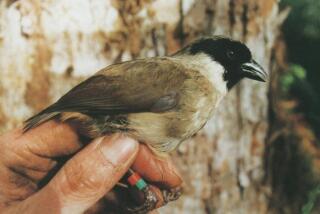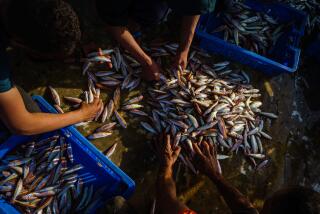Loss of Crop Diversity Hurts Hungry World : Agriculture: As varieties vanish with industrialized farming, our food supply faces nutritional impoverishment.
- Share via
In a world that lurches from crisis to crisis, it is always difficult to call attention to a catastrophe in the making. But, like many disasters engineered over long periods of time, corrective action must be taken before the momentum of impending disaster becomes too great to halt.
In the race to feed a world population that could grow to more than 10 billion in the year 2050, traditional crop varieties and local animal breeds are being wiped out at an alarming rate. New ones, better suited to industrialized farming, are becoming the world standard.
Industrialized agriculture favors genetic uniformity. When vast areas are planted with a single high-yield crop variety, traditional crops are lost and whole harvests can be destroyed by one pest or disease. The loss of this biodiversity threatens world food production and could eventually put human beings at the top of the endangered species list.
Unfortunately, the importance of maintaining the world’s plant and animal biodiversity has not always been apparent. In 1970, the United States suffered the consequences of highly industrialized farming, when southern leaf blight destroyed almost $1 billion worth of corn and reduced yields by as much as half. More than 80% of the commercial U.S.-grown corn varieties were susceptible to the disease. Eventually, resistance to the blight was found in an African corn variety, Mayorbella. A major catastrophe was averted by incorporating this resistance into commercial varieties.
Since the beginning of this century, Europe has lost half of its domestic breeds of animals. One-third of the remaining 770 breeds are in danger of disappearing in the next two decades.
Much of this loss is the result of market pressures and other incentives leading farmers to replace varied and locally adapted plant and animal varieties by a limited number of commercial ones.
Today, about 150 plant species are cultivated worldwide, while just three--rice, corn and wheat--supply almost 60% of the calories and protein derived from plants. If this trend continues, it will lead to the nutritional impoverishment of our food supply.
The biological diversity of aquatic species is threatened by habitat destruction, overexploitation and reliance on a few highly productive species. Fleets using sophisticated detection devices are too efficient at catching fish. Moreover, bottom trawl nets destroy vital habitat. About 80% of aquatic food production comes from fishing wild species in oceans, seas, rivers and lakes, yet we are in danger of losing many of these populations before we know which additional species could be domesticated and used for fish farming. While fish farming will continue to increase, its long-term viability will depend on keeping reserves of wild populations.
Though Earth’s biological diversity once seemed inexhaustible, today, with our rapidly growing population, we know the planet’s biodiversity is a finite resource. If managed wisely, it is also renewable.
While the 1992 U.N. Conference of Environment and Development in Rio de Janeiro focused world attention on preserving the environment and the world’s biodiversity, the international economic system has yet to establish a value for the preservation of biodiversity and the environment in general.
The urgency of resolving such outstanding issues can be easily understood. Just 7% of the Earth’s land surface, the tropics, is home to 75% of the world’s terrestrial biological diversity. If current trends continue, we could lose many valuable but unknown species before their worth can be evaluated.
If we are to preserve the biodiversity of plants and animals while producing enough food for the world, the cost of conservation must be incorporated in the cost of agricultural production. We must keep in mind that the price of preserving biodiversity is far less than the penalty for letting it erode. Once lost, this heritage cannot be recovered or restored.
More to Read
Sign up for Essential California
The most important California stories and recommendations in your inbox every morning.
You may occasionally receive promotional content from the Los Angeles Times.













